In the last few weeks, we have witnessed a rapidly changing situation and firm reactions of individual European governments regarding the SARS-CoV-2 virus pandemic causing the COVID-19 disease. At first, individual countries adopted various strategies to counteract the effects of the spread of a dangerous infectious disease. How has isolation during a pandemic affected the mobility of Europeans?
Western European countries were initially rather cautious, mainly recommending certain behaviors, as opposed to Central and Eastern European countries which decided to implement the most restrictive measures almost immediately. In the following days, Western Europe also started to introduce lockdown measures, with the exception of Great Britain which stuck to the strategy of building herd immunity for a long time, as well as Belarus and Sweden that still haven’t adopted the most invasive control measures.
Most of the countries introduced the following measures:
- Declaration of a state of emergency
- Closing the borders
- Closing of schools and universities
- Ban on public gatherings
- Forced lockdown
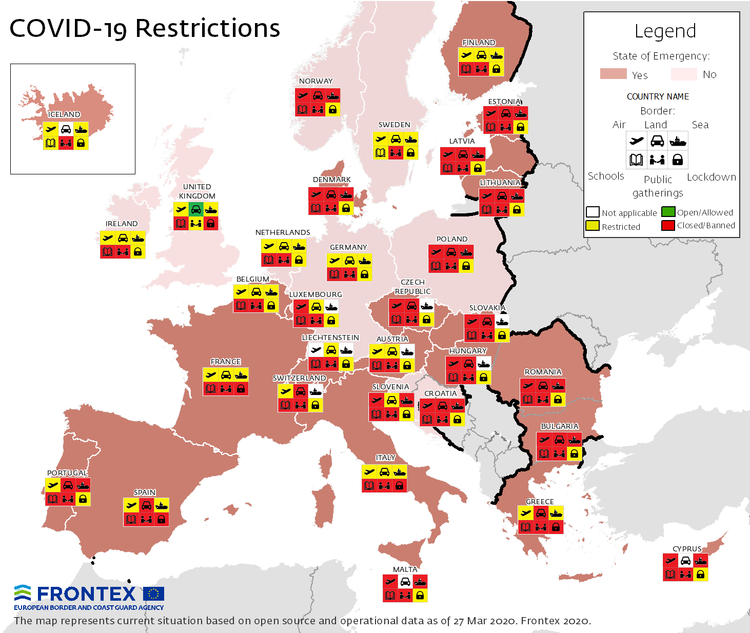
Changes in the approach to reducing the number of infected people and flattening the disease curve had a significant impact on the mobility of residents of individual European countries.
Using the collected data, RFBENCHMARK decided to check to what extent it was possible to convince the inhabitants of selected European countries to stay in their place of residence and minimize social contacts. The analysis took into account the mobility rate, which made it possible to compare the behavior of application users one week before and during the current legal restrictions with regard to leaving the place of residence.
The greatest decrease in mobility was observed in Belgium. There, the average distance covered by users (measured by the RFBenchmark User path length indicator) decreased by 91.7%. Italians (89.1%) and French (80.7%) also reduced their mobility almost completely.
The situation is different in countries that delayed the introduction of legal provisions restricting movement in public spaces and have completely abandoned preventive measures. A good example is Belarus, where the average distance traveled by users increased by 3.6%. This is the only analyzed country in which no decrease in the mobility of residents was observed. Compared to the countries of Western and Central Europe, Ukraine recorded the smallest decrease in the mobility rate (21.4%).
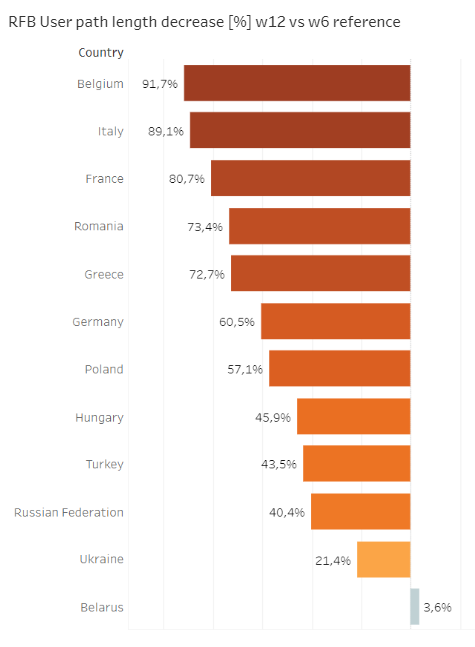
In Poland, the decrease in mobility amounted to 57.1%. This result is above the median, although it is lower than in other Western European countries. This was due to high social discipline and gradually introduced restrictions, in contrast to other countries where many residents did not follow the warnings and recommendations to stay at home, and self-isolation had to be forced by radically introduced restrictions in public spaces.
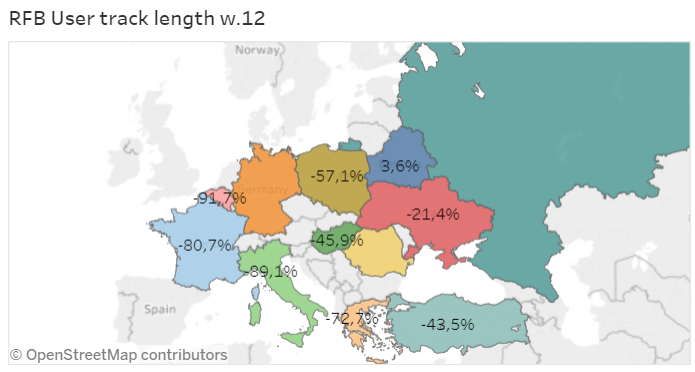
The RFBenchmark Crowd Source indicator reflects this trend pretty well. The overall user path distance was reduced down to 50% of its previous state – comments Szymon Nowak, CEO of Notel Poland.
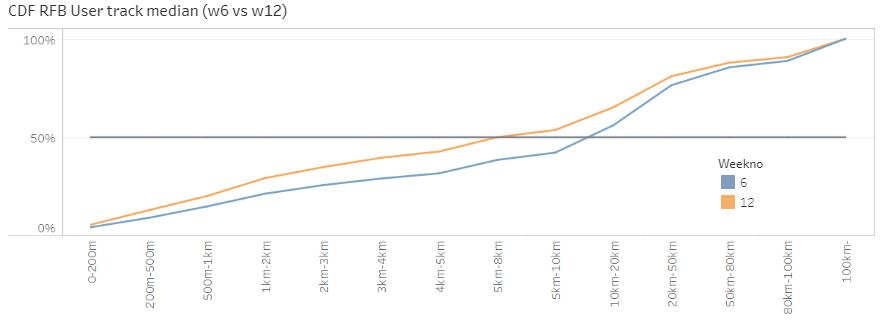
#StayAtHome and remote work impact on network performance
One of the consequences of the current pandemic is a massive shift of businesses to a remote work model. The effects are visible when comparing the performance of key indicators.
In recent weeks, we can particularly observe an increase in the interest in mobile game products and services, as well as other mobile applications that can be useful during self-isolation. The ongoing situation has also caused more and more people to spend their free time at home taking advantage of the functionality of their smartphones.
Global statistics on the average speed of downloading and uploading data on almost all continents began to fall with the imposition of restrictions on moving and leaving buildings. The only continent that has not seen any significant changes in mobile Internet speed so far is South America.
In Europe, the average data download speed has decreased from 19.6 Mbps in week 1 of 2020 to 13 Mbps in week 14. The characteristic graph collapse in week 10 coincides with the introduction of restrictions and calls to continue working from home. An almost identical trend can be observed in the statistics on the average data upload speed. In Europe, it fell from 11.1 Mbps to 8.1 Mbps with a sharp decline in week 10 of 2020.
Currently, ensuring adequate quality and stability of networks is a major challenge for telecommunication service providers.

Performance of Mobile Internet in Poland during lockdown
In Poland, there is a noticeable decrease in capacity, which affected all operators equally. In the period between week 11 and 13 there was an increase in the latency rate for most operators. The greatest increase was reported by Plus. In the same period, all operators reported decreases in the average data download and upload speed.
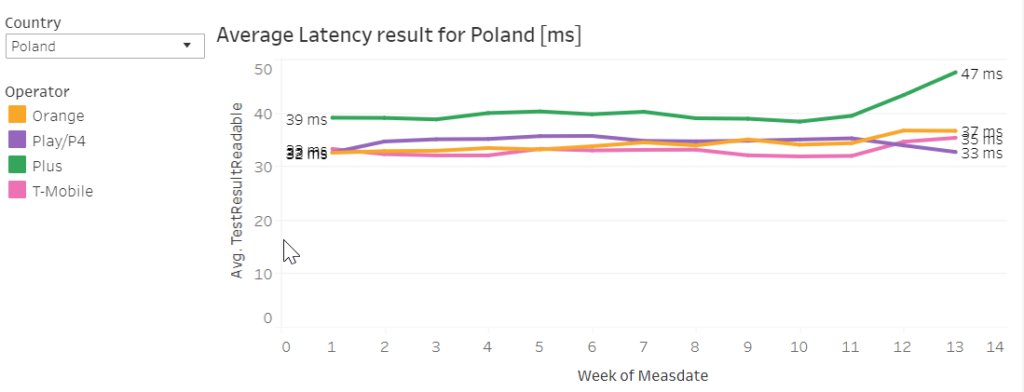
In the case of the average data download speed, the difference between week 1 and 13 was particularly noticeable for users of Plus (decrease from 15.16 Mbps to 5.87 Mbps), Play, and T-Mobile (decrease from 17.62 Mbps to 10.20 Mbps and from 16.45 Mbps to 9.11 Mbps, respectively). Orange recorded the smallest decrease (from 17.86 Mbps to 12.11 Mbps).
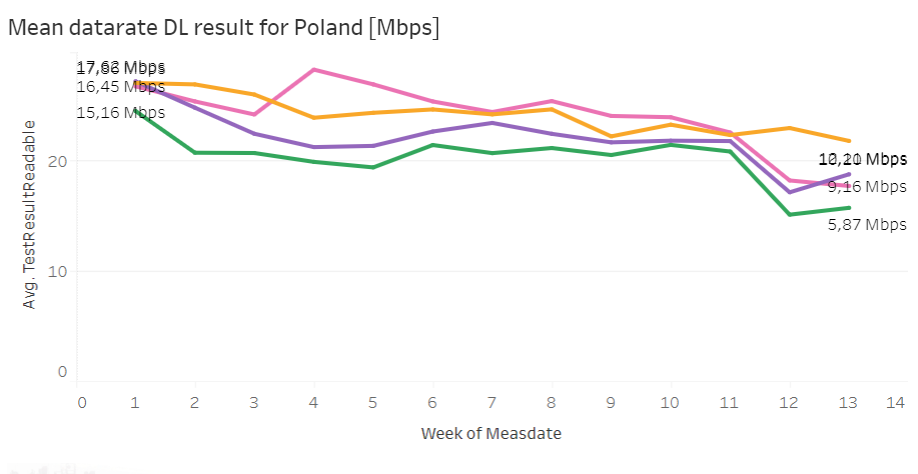
With regard to the average data upload speed, the lowest decrease was recorded by Play (from 14.97 Mbps to 9.396 Mbps) and Orange (from 15.1 Mbps to 9.982 Mbps). They were followed by T-Mobile (from 11.446 Mbps) and Plus (from 13.026 Mbps to 9.089 Mbps)
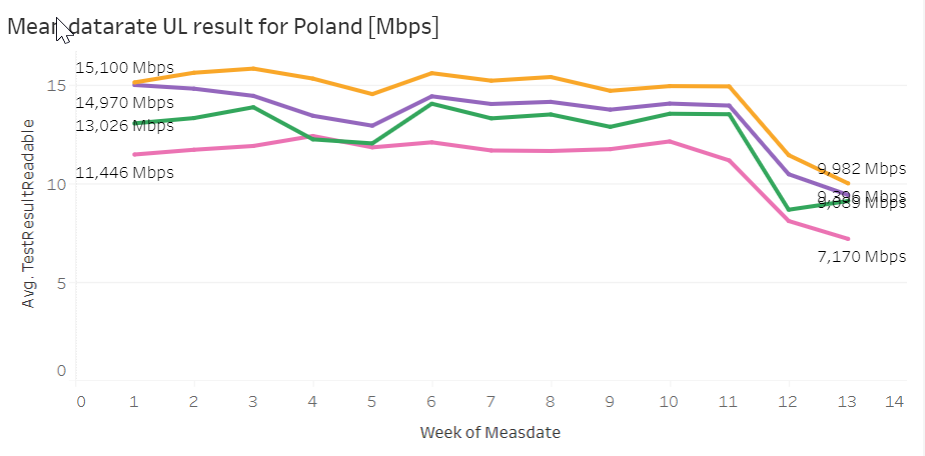
A significant decrease in mobility is also confirmed by the statistics from the application for tracking public transportation in real-time. Compared to previous months, they reported a decrease in data from passengers’ GPS devices by up to ⅔. This means that public transport services are used by far fewer people across Poland.
About RFBENCHMARK
RFBENCHMARK platform created by Notel Ltd, a leading European network performance efficiency company, allows you to check the quality of service provided by mobile network operators through access to the results of measurements carried out during independent tests (drive tests), as well as the use of a free application with the participation of all who have decided to support our project by installing the application and making their results public.
Our website also provides the latest news from the world of telecommunications and new technologies. We present new solutions and devices available on the market. We want to increase the awareness of our users and mobile network clients through publishing our results, articles and tests.
1 comment









1 Comment
Edward
3 April 2020, 11:49Not sure if stay at home really works – healthy people should work – crisis much bigger then Corona Virus # Casualties is coming soon!
REPLY